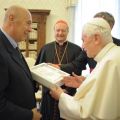Glimpsing holiness through the joy of sport
AVE MARIA, FLORIDA - Notre Dame football brings together religion and sports in a particularly pleasing way, and for this football chaplain to be on hand in Miami for the college football national championship — Notre Dame vs. Alabama — was a blessing most pleasing indeed. It was a more conflicted blessing after the opening kickoff, from which point Alabama administered a severe beating to Notre Dame en route to its third national championship in four years.
A presidential holiday season
This New Year opened with a distinctly presidential flavour. First, I saw the two hit movies about U.S. presidents Abraham Lincoln and Franklin Roosevelt. (Both I highly recommend, especially Lincoln.) Second, I received two fascinating books: The Jefferson Bible by Thomas Jefferson and The Words Lincoln Lived By from Lincoln historian Gene Griessman.
- By Robert Brehl
Oh Christmas tree!
I am not a convert. Yet. But I confess to having taken meaningful steps away from my ancient iron-clad convictions.
The steps are, in fact, inevitable since they lead me from my dark, cramped basement office past the living room where my wife has set up, decorated and illuminated a beautiful Christmas tree. There I’ve said it. We have a beautiful Christmas tree in our house.
Not long ago — I’m talking, oh, last week — it would have been easier for Oliver Cromwell to beg the Pope’s blessing at Midnight Mass than for me to bring the words “beautiful,” “Christmas tree” and “our house” within a light year of each other.
I grew up loving Christmas. And loathing Christmas trees. Always hated them. Never could abide the wretched things. When I was about five, I got smacked across the face by an evil branch on some odious Yuletide sapling my father was bringing home. When I was about 25, I suffered agonizing frostbite on my ears one brutal December night in Edmonton after being forced outside to buy a ridiculous lump of pine.
Going bareheaded was my defiance of the whole reprehensible ritual of tree shopping. It was tactical defiance. My plan was to make it essential that we grab the first tannenbaum at hand, no matter how scrawny or mangled, and vamoose before my head froze. The glowing white circles of pain on both my ears gave proof how well that scheme worked.
Frankly, I would now rather go shoe shopping with a three-legged woman than endure the torments of touring the local Christmas tree lot. Indeed, the two adventures bear a remarkable resemblance. In both, everything must be circled, touched, inspected, hoisted and balanced, sized, deemed worthy and then suddenly and inexplicably unworthy, several times before grudging approval and final settlement are reached. For a dead strip of leather. Or a dead stretch of tree.
My wife, you’ll have guessed, buys our trees. That’s because she insists we have a tree. I go along — as long as I don’t have to have anything whatever to do with the thing itself.
I have never, Cromwell-like, tried to ban Christmas trees from our house just because someone else might enjoy them. I am not a Christmas tree dog in the manger. On the contrary, I once got a tiding of great joy from a Christmas tree when one of our three cats took a flying leap, put what looked like a professional wrestling hold on the angel at the top, and rode the whole collapsing mass down to the living room floor below. I still give that kitten extra supper just to say thanks for a job well done.
My opposition to Christmas trees is, in fact, rooted in cold logic. What, I have always asked, is the point of dragging a tree into the house just because it’s December? Do we carve up slabs of lawn and slap them down on the kitchen floor because it’s April? Do we pile autumnal leaves over the flat-screen HDTV because it’s September? No. We do not. We leave outside what belongs outside. Right?
Yes. Except this year my wife lost her mother in January, her father in mid-November. Early in December, she brought home a box of decorations that had been on virtually every tree put up in her family’s house for the past 50 Christmases. Suddenly, the quintessential Santa that I would have scorned as emblematic of Christmas commercialization became a symbol of childhood magic and memory. Suddenly, the glittery guitar, violin and harp that I would once have derided as tchotchkes are all that is left of the music my father-in-law filled the house with each Christmas. The bright red and yellow glass balls for the tree branches went from baubles of banality to fragile reminders of loving hands that will lift and place them no more.
“The great light, of which the Christmas tree is a sign and a reminder, not only hasn’t dimmed with the passing of centuries and millennia, but continues to shine on us and enlighten each person who comes into this world, especially when we go through moments of uncertainty and difficulty,” Pope Benedict said last week at the lighting ceremony in St. Peter’s Square.
Beautiful words that are, I confess, entirely made manifest by our beautiful tree. I am not yet a convert, Holy Father. But give me a few more steps.
A special gift on Gaudete Sunday
Clothes may make the man, but vestments don’t make the priest. The Mass is holy whether the priest is wearing beautiful vestments or something akin to a picnic blanket. That being said, liturgical vesture does matter; it doesn’t make the priest or the Mass, but it can make both the priest and the offering of the Mass more worthy of the right worship of God.
We have emerged from a long period in which the norm in many Canadian parishes ranged from merely adequate to hideous. Happily though, in recent years one rarely sees the detritus of the 1970s, chasubles made out of rough fabrics and felt and apparently decorated by small children with poor motor skills. The same renewed care for the liturgy that resulted in the vastly improved new translation of the Mass is also manifest in priests choosing vestments that are elegant and evocative of Catholic devotions. Vestments ought to inspire the faithful to lift their vision toward divine things, not to avert their eyes altogether. It may even be that a priest more suitably adorned for the Mass might inspire the faithful to dress more elegantly too.
I think about vestments in a particular way on Gaudete Sunday, when the liturgical colour is rose, not the usual Advent violet. I am blessed to have more vestments than priests usually do. Some were made by my own mother, and others were made or purchased abroad, where vestments can be had at a fraction of the prevailing prices in Canada. Many of them have stories — made for my first Mass, for my sister’s religious vows, bought for an anniversary or at a particular holy shrine — but my Gaudete Sunday rose chasuble has the best story of all.
In 2002, I was studying in Rome and Msgr. Charles Elmer, a long-time faculty member and spiritual father at the Pontifical North American College, had his 50th anniversary of priestly ordination that Dec. 20. The College celebration was set for Gaudete Sunday, and I asked Msgr. Elmer, both a friend and mentor, if there was anything he wanted. The old priest, who lived very simply, said he would like to offer his anniversary Mass in the same kind of Roman chasuble that he wore at his ordination in 1952 at St. John Lateran in Rome. The College did not have a rose-coloured Roman chasuble, so to honour a priest greatly beloved and admired, I bought Msgr. Elmer a new one, simple but elegant, from Gammarelli, the Roman ecclesiastical haberdasher. He was touched and happy.
We did not count on the objection of the College’s then liturgical director, a younger priest. Whether he objected to using something the College did not own, or whether he objected to the Roman vestment, or whether he took perverse delight in asserting his authority against a priest more senior than he, I do not know, but he told Msgr. Elmer that because the dozens of concelebrants could not all wear rose, the rose chasuble could not be worn. He was wrong on liturgical grounds, and it was wrong to deny the modest request of a venerable priest. (When a few years later he suffered the acute embarrassment of being dismissed in mid-semester, I thought it well-deserved, though I regretted it was for other behaviour, and not for how he had treated Msgr. Elmer.)
In any case, Msgr. Elmer, a D-Day veteran, handled the situation with humility and grace. He declined to do what I advised, which was to show up in the sacristy clad as he wished and dare anyone to tell him otherwise. Instead, he took me aside, thanked me for the gift and said that he would do that if I insisted, as I had bought him the gift he had desired. But his own preference would be to obey the whims of the liturgical director. I was disappointed for him, and angry too. I was quite eager for a fight. Msgr. Elmer taught me that one goes to Mass not eager for a fight but ready to receive a gift. And so he gave me one.
“Raymond, I am an old man now and not many years are left. You are just newly ordained. I am grateful for your gift, but now do me another kindness and receive this gift back from me to you, from an old priest to a young one,” Msgr. Elmer told me. “You will have many Sundays to wear it, I will have few.”
Msgr. Elmer actually had eight more Gaudete Sundays; he died in September 2011. This year would have been his 60th anniversary. I received back the gift I had given, and every Gaudete Sunday I wear it, remembering a great priest who knew how to rejoice in the Lord always.
Living the Christmas mystery with The Hobbit
Making Jesus the centre of Christmas is an important and worthy endeavour, if also a challenge in our increasingly secular culture.
Putting Christ back into Christmas evokes St. Paul’s reminder of what it means to live as a follower of Christ. “Put on Christ,” he encourages us in his Letter to the Romans (Rom. 13:14).
The ways that we seek to focus on Jesus’ birth this Christmas can help us develop some spiritual practices to make Christ the centre of our everyday lives.
One of my guides this Advent has been Bilbo Baggins, the unlikely and humble hero of The Hobbit, by J.R.R. Tolkien. (I re-read this childhood favourite so that I could fully appreciate the film, The Hobbit: An Unexpected Adventure, currently playing in theatres.) Despite the lack of an overt Christmas theme, Bilbo’s adventures can offer some insight for our spiritual journey.
Christmas celebrations are full of great art — or at least imitations of great art. (We have all had occasion to shudder at an off-key rendition of our favourite Christmas hymn.) Great art — whether visual, literary, musical, cinematic or narrative — reminds us of our true human nature, as God created us. When a work of art expresses the best of what it means to be human, this goodness can be a starting point for dialogue with our secular culture. It can also become a doorway to spiritual awareness for the believer and non-believer.
Engaging with a great work of art becomes an adventure of the kind that Bilbo Baggins goes on. The newness of his experiences makes the little hobbit keenly sensitive to the beauties and dangers around him. His dwarf companions seek to regain lost treasure, but Bilbo goes on the journey for entirely different reasons. Ultimately, he is transformed — by the beauties he experiences, the goodness he witnesses in others, the dangers he faces and the choices he makes.
We can choose to engage our secular culture with a similar sensitivity: both to the seeds of the Gospel it contains and to its innate dangers. Especially at Christmas when the artistic expression is often clearly Christian, we can highlight the best of these expressions of faith. Instead of just listening to the radio, we can play a mix of religious hymns, letting their awe and wonder flood our hearts. We can look more closely at the masterpieces on our Christmas cards, even using them in our prayers as a way to meditate on the amazing mystery of the Incarnation.
Throughout the year, we can become like the magi, seeking Christ in the secular corners of our culture.
Gift-giving in a consumer culture easily becomes an exercise in impressing others, a way to “prove” our love by how much money we spend, or a way to “use” one another — gift-giving in the hopes of getting something back. Consumerism falsely fulfills our insecurities through the acquiring of more and more material things.
In The Hobbit, the dwarves’ attitudes toward the dazzling treasure are quite consumeristic. Bilbo is the one who sees the gold for what it is: useful only up to a certain point. His brushes with gold help him to see with a spiritual vision and to choose friendship over treasure, honesty over deception, justice over greed.
As Bilbo clearly saw, material things are gifts to be used and shared. We can strive to make our Christmas gifts more authentic expressions of love, more personal and meaningful: a homemade gift card for going out for ice cream together; a hand-crafted item; a favourite spiritual book. This personal approach shifts our focus from the gift to our relationship with the person receiving the gift. Gift-giving then takes its proper place as a celebration of God’s abundant love for us.
Throughout the year, we can continue to shift from our consumeristic, “gotta-have-it” attitude to a deepening perspective of gratitude. We can seek to share what we have received, giving of ourselves with greater love.
Christmas Mass is where we celebrate the ultimate gift: God’s coming to us. This coming of God is a mystery and a grace to be celebrated year-round with a humble and brave “hobbit-like” heart that views the spiritual life as a quest for a more abundant life. Every Mass — not just Christmas — becomes an invitation for us to cherish the coming of our God, to welcome Him, and to respond to His coming with love.
St. Joseph, a small but great man of history
At his Angelus address on Dec. 9, Pope Benedict commented upon the Sunday Gospel, in which St. Luke carefully lists the various rulers, sacred and profane, when St. John the Baptist began his preaching.
There’s something about the name Mary
Fewer baby girls are gifted with Our Lady’s name nowadays
Earlier this month, Today’s Parent published its annual list of most popular baby names in Canada and I scanned, as I usually do, to see where my two children’s names are located.
- By Robert Brehl
Where’s the consistency?
A one-month suspension given to a Montreal radio host who allowed, or perhaps tacitly encouraged, anti-Semitic commentary on his phone-in show has provoked considerable debate as to whether the punishment is in proportion to the breach of ethics.
Jacques Fabi has been on the air for 35 years and is described as “king of the night” at his midnight to 5:30 a.m. phone-in show on 98.5 FM. On Nov. 22, a caller identifying herself as Maria launched into a hate-filled rant against Jews and Israel, even including some praise for the Holocaust. Of concern is not just that the caller got through the station’s normal screening procedures, but also that she was not stopped immediately by Fabi, who instead added a few comments of his own, including that despite freedom of expression, “it is very difficult to make any negative comments about Jews.”
He allowed the conversation to go on for some time and at the end politely thanked the contributor for her call. In his subsequent apology, portions of which were printed in the National Post, Fabi said he would never endorse the caller’s “anti-Semitic comments” nor trivialize the Holocaust.
“For 35 years I have hosted a nighttime call-in segment and it is not the first time that a listener has tried to use it as a vehicle for communicating unacceptable messages,” he said. “I have always reacted quickly in order to avert these situations. Unfortunately, I did not last week.”
For some people, the apology should have been enough, but for others the suspension, as well as the censure of his peers, is appropriate. I agree with the suspension, since it underlines the importance of responsibility on the part of those who control the use of broadcasting outlets. This is not the “wild west” of the Internet, where technically it is almost impossible to regulate web sites operated by the hateful and the twisted. The fact that people are free to hold opinions doesn’t mean that a radio station is obliged to provide a platform for them.
With that said, it would be nice to see some consistency in standards. Just a few weeks before the Montreal incident, John Tory’s suppertime drive-home show onToronto’s NewsTalk 1010 included, during panel conversation, a joke by panelist Gail Vaz-Oxlade about the Pope and masturbation. I know of at least a dozen e-mails being sent to the station about the remark. Many were unanswered. Of those that were, the brief apology was of the “just a joke” and “no offence intended” variety.
I’m not suggesting that a sick joke about a public figure is on the same level as vile anti-Semitism, but for some people the “joking remark” about the Pope was almost as offensive, and it was at a time of day when many more people were likely to hear it.
Over the years, the Catholic Civil Rights League has protested dozens of incidents of anti-Catholic content on radio and television, including a Jesus look-alike contest at Eastertime and a Christmas special that portrayed the Virgin Mary as, shall we say, a party girl. While there have been a few apologies from individual stations, I’m not aware of a single case where the Canadian Broadcast Standards Council has upheld a complaint about anti- Catholic content, especially if there was any sort of humourous context involved. That is why, for many believers, the dial often goes to the “off” position.
The Montreal episode is a reminder that action from the station is as important as action by the listener.
***
In response to the annual barrage of Christmas and “holiday” advertising, the American Family Association is compiling its “Naughty or Nice List” for 2012. It singles out major North American retailers that avoid using or ban the term Christmas in their advertising, as well as identifying those that still use it.
I understand the reasoning behind this but still I wonder about the fairness of singling out retailers for something that is widespread and to which we all contribute by accepting the “bigger every year” commercialization of Christmas. While we’re free to “report” stores that are reluctant to use “Christmas” in advertising and in-store greetings, I have always found the simpler solution is to wish a Merry Christmas to those we buy from, but also to happily accept any and all greetings in the spirit in which they’re intended.
Salt+Light is alive!
And still going strong after 10 years
I have been writing about a lot of anniversaries this year — 1,700 years since Constantine’s victory at the Milvian bridge, 500 years since the completion of the Sistine Chapel ceiling, 50 years since the opening of the Second Vatican Council. In the secular calendar, we have had the diamond jubilee of Her Majesty Queen Elizabeth and the 30th anniversary of the patriation of the constitution, including the Canadian Charter of Rights and Freedoms.
In the light of all that, 10 years may not seem like very much — though I did write about my own 10th anniversary of priestly ordination this past summer. Another anniversary comes this week. Ten years for Salt + Light Television, and it is an occasion worth celebrating.
Fr. Thomas Rosica, director of World Youth Day 2002 in Toronto, founded Salt + Light TV in the months after WYD, with the generous support of the Gagliano family. The name Salt + Light came from the theme of the WYD itself, taken from the Sermon on the Mount, where Jesus tells His disciples that they are to be the salt of the earth and the light of the world.
This week Salt + Light marks 10 years since its establishment, even though it did not begin broadcasting until June 2003. The major celebratory event was the Dec. 5 Christmas concert with The Priests, but we had something of an anticipated celebration in Kingston when Fr. Rosica and Sebastian Gomes visited our archdiocese Dec. 2. They offered two presentations — one in Sebastian’s home parish in Perth, Ont., and the other at our cathedral — on the new evangelization, reporting on their experience at the recent synod on the new evangelization in Rome.
Fr. Rosica served among the synod officials, briefing the English-speaking journalists. Gomes is one of the network’s dynamic young journalists who, along with his colleague Cheridan Sanders, covered the synod. Their report stressed two points. First, that the new evangelization is not to teach people about Jesus, but to help people encounter Jesus. Second, that faithful Catholics themselves have to be converted anew and feel a new enthusiasm for their faith. Without this new enthusiasm, we won’t desire to share our faith with others.
Salt + Light, a powerful initiative for the new evangelization in Canada, is entering its second decade launching a new program that attempts to do just that. Hosted by Gomes and Sanders, The Church Alive takes its title from Pope Benedict XVI’s inaugural homily, wherein he proclaimed that the “Church is young, the Church is alive.” It was not exactly the “be not afraid” of Blessed John Paul II’s inaugural homily, but it speaks of Benedict’s priority for the new evangelization. The Church is alive in Jesus Christ to be sure, but needs to become more lively, precisely in those places where the Church is in critical condition.
The Church Alive is described as “fast-paced,” meaning that its pilot episode covers the year of faith, the Second Vatican Council and Blessed John XXIII in the first four-and-a-half minutes. It’s aimed at making young Catholics excited about their faith and equipping them to share it with their contemporaries. This is not your grandmother’s religious TV. Gomes on the documents of Vatican II: “These are absolutely huge.”
Huge, indeed. Imagine what that would make Ephesus or Trent. Enormous.
Gomes and Sanders are just the latest innovation from Salt + Light in presenting the faith. Gomes reveals something of the Salt + Light secret when he says that the staff at Salt + Light is not permitted to say that something can’t be done, or that we have never done it that way before.
The new evangelization requires, by definition, new methods. And so not having done something that way before is often an advantage. At 10 years, Salt + Light is no longer new, but it is still doing new things and is very much part of the new evangelization in Canada.
Having led the reform of the Newman Centre at the University of Toronto in the 1990s, World Youth Day in 2002 and now Salt + Light for 10 years, Fr. Rosica is becoming — if one might put it this way — a young elder of the new evangelization. The continuing good news about Salt + Light is that there are a great many young evangelists following behind him. Salt + Light — ad multos annos!
Modernism: it’s all about me, myself and I
And it’s amazing that no one questions this
Coronation anthems and Christian culture
As the days grow colder and the nights longer, George Frideric Handel returns to the choir loft and the concert hall, to say nothing of the shopping mall. The naturalized British composer’s Messiah is sung by amateurs and professionals alike in these weeks. All of which is rather curious, for the celebrated “Hallelujah Chorus,” in salute of which both princes and peasants rise to their feet, is part of a vast biblical libretto — stretching from Isaiah to Revelation — and takes its place after the Ascension. So the chorus properly belongs more to Easter than Christmas, but Christmas is where it has stuck in our cultural imagination.
Handel though, especially this year, could be considered a fitting adornment for Christ the King. In 1727, Handel was commissioned by King George II to compose anthems for his coronation. Handel composed four anthems for the occasion. So magnificently did he fulfil this royal patronage that his music is now perpetually associated with the coronation of British monarchs.
Thus it was an inspired decision by the Melos Choir and Chamber Orchestra of Kingston to perform the coronation anthems at St. George’s Anglican Cathedral in celebration of the diamond jubilee of Her Majesty Queen Elizabeth II. St. George’s just being a short walk down Johnson Street from our own Cathedral of the Immaculate Conception, it was easy enough to attend the Sunday afternoon concert before returning to offer the evening Mass. For good measure, I took along the students who sing at Newman House for an afternoon of Christian culture.
Handel’s coronation anthems are settings of biblical passages which, when employed for coronations, make manifest that kingship in this world is to be patterned on the kingship of Christ. The aspiration of kings should be — literally — the listening heart of Solomon, that he might govern the people wisely.
King Solomon is the focal point of the most famous of Handel’s anthems, “Zadok the Priest.” The text is an adaptation of I Kings 1:38-40: “Zadok the Priest and Nathan the Prophet anointed Solomon King; and all the people rejoiced, rejoiced and said: ‘God save the King! Long live the King! God save the King! May the King live forever. Amen. Alleluia!’ ”
That biblical text has been used in every coronation of English (and later British) monarchs since that of King Edgar in 973 at Bath. Handel’s setting, after its spectacular debut in 1727, has been repeated at every coronation, including that of Queen Elizabeth 60 years ago. Indeed, after King George II died, composer William Boyce was commissioned to produce new settings for the coronation in 1761 of King George III. Boyce accepted, but declined to provide a new setting for “Zadok,” arguing that Handel’s setting could not be improved upon. He was right.
The Melos musicians did a splendid job of performing the anthems, and the setting of the Anglican cathedral was a reminder that these anthems are properly prayers for a gracious and noble sovereign, even as the royal anthem of “God Save the Queen” is a simple prayer.
The coronation anthems — in addition to “Zadok,” they include “My heart is inditing,” “Let Thy hand be strengthened” and “The King shall rejoice” — constitute a corpus of Christian culture. They are liturgy which soars, combining splendid sacred music with the word of God. As music does at its best, they mark something of the majesty of a moment and bring it easily to mind upon hearing just a few bars. As “Adeste fidelis” or “O Holy Night” immediately bring to mind Midnight Mass, the coronation anthems, even if performed at the concert hall instead of a cathedral, bring to mind not only the pomp and pageantry, but also the sacral character of Christian kingship.
As a liturgical genre, the anthem is an Anglican speciality, combining the textual brevity of a Roman antiphon with the power of a great hymn. The coronation anthems are a fine introduction to anthems for Catholics who may be unfamiliar with them.
A final treat from the diamond jubilee sacred music concert was the singing of the royal anthem — and not just the first verse of “God Save the Queen.” Here’s the Canadian verse for our Queen: “Our loved Dominion bless with peace and happiness/ From shore to shore/ Let our Queen’s realms all be united, loyal and free/ True to themselves and thee/ Forevermore.”
Listen to Handel’s Messiah this December to be sure; but even before Advent begins, in this week of Christ the King, listen to the coronation anthems, from the composer of Christian kingship.








